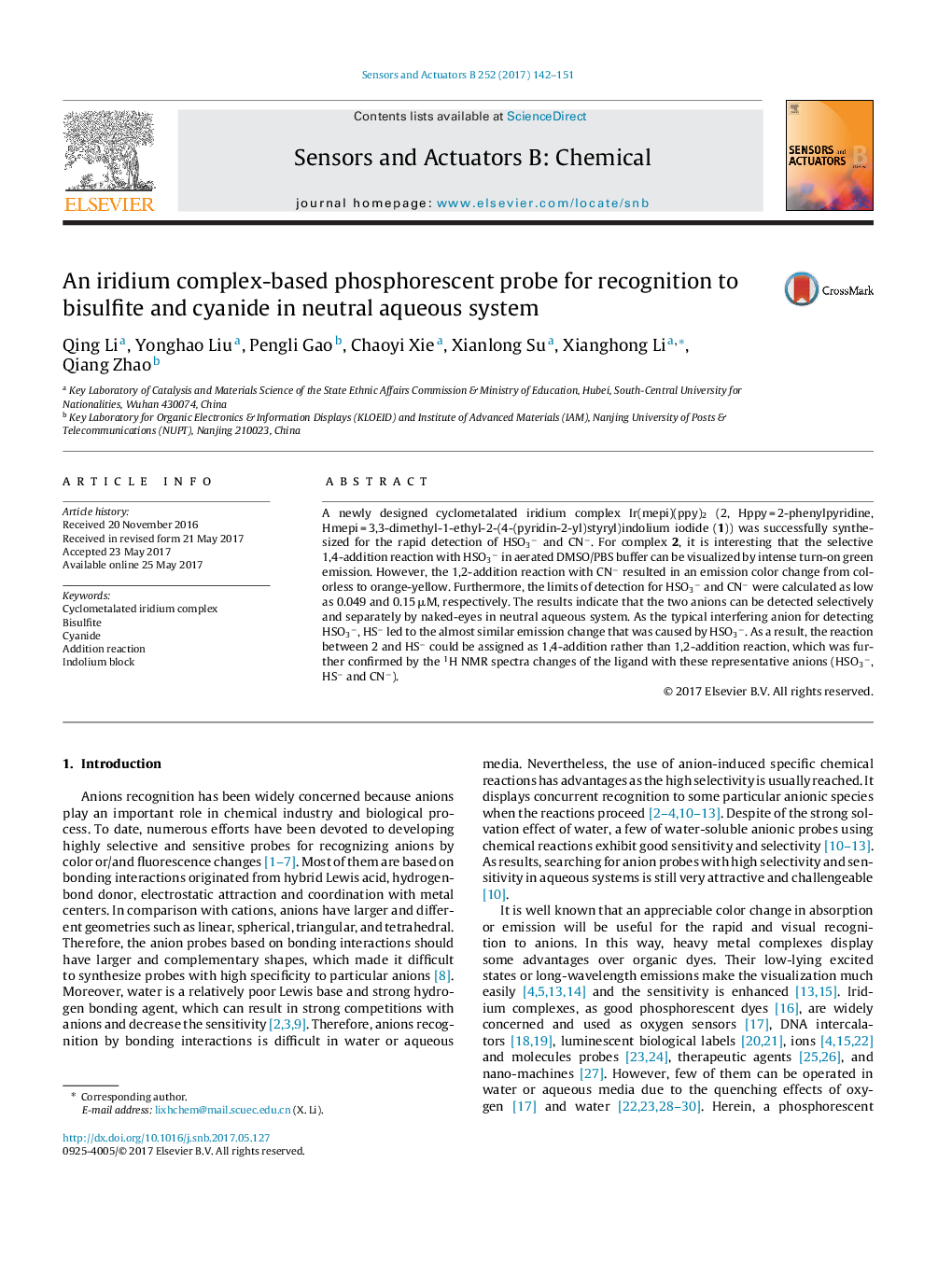| کد مقاله | کد نشریه | سال انتشار | مقاله انگلیسی | نسخه تمام متن |
|---|---|---|---|---|
| 5009060 | 1462039 | 2017 | 10 صفحه PDF | دانلود رایگان |
• A new iridium complex was successfully synthesized.
• In aerated PBS buffer, bisulfite and cyanide can be easily discriminated by the different phosphorescent colors of the complex.
• The reaction between the complex and HS− could be attributed to 1,4-addtion rather than 1,2-addition.
A newly designed cyclometalated iridium complex Ir(mepi)(ppy)2 (2, Hppy = 2-phenylpyridine, Hmepi = 3,3-dimethyl-1-ethyl-2-(4-(pyridin-2-yl)styryl)indolium iodide (1)) was successfully synthesized for the rapid detection of HSO3− and CN−. For complex 2, it is interesting that the selective 1,4-addition reaction with HSO3− in aerated DMSO/PBS buffer can be visualized by intense turn-on green emission. However, the 1,2-addition reaction with CN− resulted in an emission color change from colorless to orange-yellow. Furthermore, the limits of detection for HSO3− and CN− were calculated as low as 0.049 and 0.15 μM, respectively. The results indicate that the two anions can be detected selectively and separately by naked-eyes in neutral aqueous system. As the typical interfering anion for detecting HSO3−, HS− led to the almost similar emission change that was caused by HSO3−. As a result, the reaction between 2 and HS− could be assigned as 1,4-addition rather than 1,2-addition reaction, which was further confirmed by the 1H NMR spectra changes of the ligand with these representative anions (HSO3−, HS− and CN−).
A newly designed cyclometalated iridium complex Ir(mepi)(bpy)2+ (bpy = 2,2′-bipyridine, Hmepi = 3,3-dimethyl-1-ethyl-2-(4-(pyridin-2-yl)styryl)indolium iodide) was successfully synthesized for the rapid detection of HSO3− and CN− in aerated DMSO/PBS buffer. It is interesting that the addition of bisulfite to the buffer results in an intense turn-on green emission due to the 1,4-addition reaction, while an orange-yellow emission caused by cyanide was observed due to the 1,2-addition reaction. The green emission for the ensemble of the complex and HS− is almost similar to that of bisulfite indicated that the reaction between the complex and HS− can be assigned as 1,4-addition reaction rather than 1,2-addition. All these results were further confirmed by the characteristic data for reactions between the ligand (Hmepi) with these anions. Moreover, the limits of detection for HSO3−, HS−and CN− were calculated as low as 0.049, 0.30 and 0.15 μM, respectively. Filter paper test exhibited that these anions can be detected selectively and separately by naked-eyes.Figure optionsDownload high-quality image (105 K)Download as PowerPoint slide
Journal: Sensors and Actuators B: Chemical - Volume 252, November 2017, Pages 142–151
